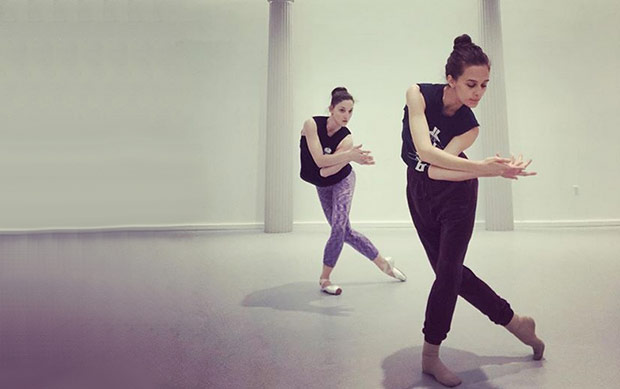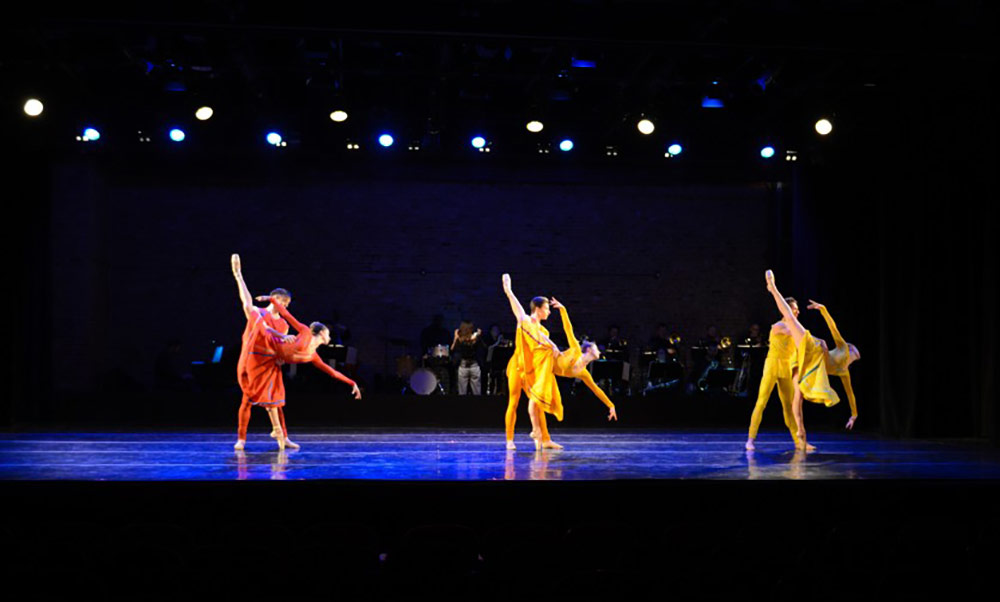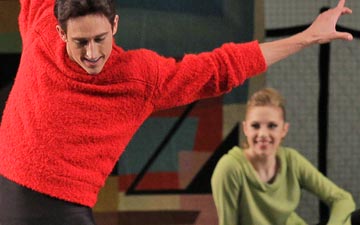
© Gibney/Ashley Bouder – from Instagram original.
Ashley Bouder Project
Red Spotted Purple, Duet, Alas, Symbiotic Twin, In Pursuit Of
Joyce Theater Ballet Festival
★★★✰✰
New York, Joyce Theater
2 July 2018
www.theashleybouderproject.com
www.joyce.org
Onward Ballet
The Joyce’s Ballet Festival, now five years old, is an attempt to take the temperature of the ballet world beyond the walls of the big companies. What interesting collaborations are happening? Which dancers are striking out on their own to create new ensembles? Who are the choreographers whose work we don’t regularly get to see on the opera house stage?
This year’s edition includes five ensembles, of varying size: Dimensions Dance Theatre of Miami, founded by two former Miami City Ballet members. Move: The Company, started by a Canadian choreographer, Joshua Beamish. BalletX, from Philadelphia. Barak Ballet, of LA. And the Ashley Bouder Project. The latter is the only one in this group led by a dancer currently on the raster of a large company (New York City Ballet). I caught Bouder’s show on July 2, opening night.
Bouder has been outspoken about the need for change in ballet: more space given to women’s voices, more female leadership, more diversity, less emphasis on ballet’s traditional gender-based division of labor. (Men lift, women are lifted, etc.) Her pick-up ensemble of eight, which she refers to as an arts collaborative, reflects her ideals. It is racially diverse; the choreographers include both men and women. Not all the choreographers are white. This should be par for the course, but it’s not.
Bouder has also made the doubtless costly, but artistically important choice to include live music. It makes all the difference – any performance, even a mediocre one, would benefit from being backed up by a band as versatile and vibrant as the New York Jazzharmonic, led by Ron Wasserman. The musicians, who played everything from a new commission by the young American composer Stephanie Ann Boyd and a minimalist score by Kate Moore, to a jazzy composition by Miho Hazama – note the female composers – injected energy and life to the evening.
All of the dancers but one, Damien Johnson, came from New York City Ballet (Johnson was a longtime member of the UK’s Ballet Black) and their brilliant technique was a major source of pleasure. Claire Kretzschmar, currently in the corps, is a knock-out; a long-limbed, shape-shifting dancer with a hunger for movement and a way of vibrating to the music that seems to ignite the air around her. You can see the music pulsing through her limbs, like electricity. Taylor Stanley is equally riveting: mysterious, intensely focused, able to transition from one quality and position to the next – aerial, terrestrial, fast, slow, heavy light – without warning. Roman Mejia: energetic, powerful, and a charmer. And of course, Bouder herself, a dancer of enormous aplomb, speed, and strength. If only she could tone down her tendency to stare out insistently at the audience.
Of the four works, my favorite was the world premiere Alas, by Abdul Latif. This, despite Latif’s use of Max Richter’s reinterpretation of Vivaldi’s “Spring” from The Four Seasons, a score seemingly irresistible to young choreographers. Luckily, the ponderous Richter had been rearranged and re-orchestrated by Wasserman for jazz orchestra and violin, intermixed with a vocal riff performed Mr. Latif himself. The choreography, full of shifts in speed and dynamic, projected a great sense of freedom. Torsos moved, arms wind-milled, legs whipped through the air. Toward the end, the dancers were propelled by a strong rhythmic groove; they looked unleashed by it. Only one section, a trio, lost focus, meandering and ending abruptly. But the finale, set to Henry Purcell’s stately rondeau from Abdelazer, grew in an impressive crescendo, with each dancer adding to the intensity of the group as a whole. I’d love to see more of his work and I should – Latif is currently in the process of starting his own company.

© Diana Mino. (Click image for larger version)
Lauren Lovette’s solo for Bouder, Red Spotted Purple, was a bit too cute, and Annabelle Lopez-Ochoa’s Symbiotic Twin, for Bouder and Stanley, overladen with the eccentric details that often makes her work appear more ornamental than organic. Bouder’s own In Pursuit Of, was a jazzy charmer in the style of Jerome Robbins with dancers watching other dancers and relating to each other. But Duet, created by the post-modern choreographer Liz Gerring and performed by Damien Johnson and Taylor Stanley to more or less atonal music (by Anna Webber), was something more substantial, an intriguing exploration of imitation, repetition, and contrast. Gerring’s choreography has the strong, clear, and unaffected articulation one associates with Merce Cunningham. One phrase does not follow upon the other; there is no attempt at creating a “logic” behind the steps, at least not one that the audience can follow.
One dancer might jump in place, twisting his upper body, as the other moves backward through space, like an ice-skater in reverse. The two men tilted and turned, independently of each other. They barely ever touched. Only toward the end, in a passage during which they danced in close proximity, did Stanley lean against Johnson briefly in order to sustain a balance. The contact had no emotional or narrative purpose at all, merely functional. The costumes, work shorts and tank-tops, were just that: comfortable clothes to move in.
Does it matter that, as the program points out, the duet was originally composed for two women? Not really. Cross-gender casting is hardly new in the modern-dance world. There is nothing specifically male or female about Gerring’s movements. All that matters here is that the two dancers perform beautifully, objectively, with riveting focus.
What’s evident from this performance by the Ashley Bouder Project is that behind the programming and the artistic decisions, there is a clear-sighted mind at work. Bouder has a good sense of what she wants, what she likes, and the ability to produce it effectively. This project has legs.

















You must be logged in to post a comment.